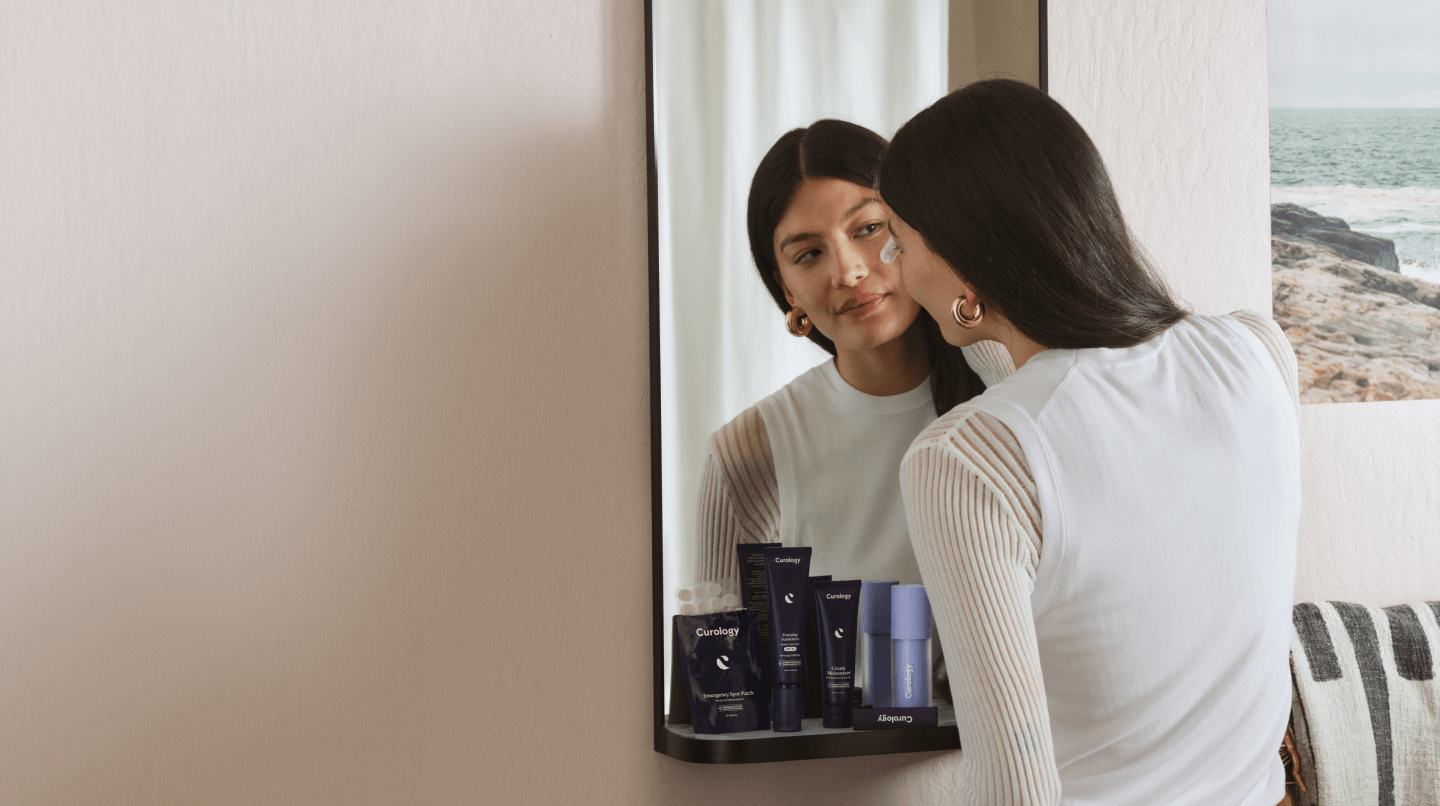How it works:
Share your skin goals and snap selfies
Your dermatology provider prescribes your formula
Apply nightly for happy, healthy skin
How it works:
How it works:
Share your skin goals and snap selfies
Your dermatology provider prescribes your formula
Apply nightly for happy, healthy skin
How it works:
Adenosine in skincare: what to know about this anti-aging ingredient
Commonly used in a medical setting, this chemical compound is also used in skincare.



When you want skincare that works, it’s all about using the right ingredients. And if you’re interested in getting an anti-aging effect from your products, it might be time to look for ones that are formulated with adenosine. Although commonly used to treat irregular heart rhythms in a controlled hospital setting, this naturally occurring chemical compound is now a new favorite in skincare products.
Curious to learn more? Allow our dermatology experts to explain everything you need to know about adenosine in skincare: What it is, how it’s used, and safety precautions to consider when incorporating it into your routine. Let’s dive in.
What is adenosine?
Adenosine is a naturally occurring substance that has many important roles within the body. One role it plays is that of a vasodilator.¹ Vasodilators allow for the blood vessels within the body to relax and widen, allowing blood flow to increase in areas where it is needed. In fact, adenosine is often used to help regulate a person's heart rate when they are in certain irregular rhythms.² However, adenosine is becoming popular in many anti-aging and skincare products.
Products containing adenosine
Though it may be present in small amounts, adenosine has shown promise in cosmetics and skincare. Given its potential anti-aging and tissue repair properties, you may find it in skincare products such as:
Facial moisturizer
Face masks
Face serums
Eye cream
CC cream
Concealer
Foundation
And more!
Adenosine in skincare benefits
What can adenosine do for your skin that’s so special? Multiple benefits may arise when skincare products include adenosine.
Anti-wrinkle effects
Researchers have identified adenosine as a potential anti-aging skincare ingredient, as it smooths the appearance of wrinkles. More specifically, one study evaluated the effect of adenosine-containing products, reporting a significant reduction in the appearance of glabellar frown lines as a result of their use.³
Additionally, other studies reviewed dissolvable films⁴ and microneedle patches containing adenosine and discovered the improvement in participants' crow’s feet and other wrinkles.⁵
Improved collagen production
As we age, the overall collagen content in the skin surface diminishes (1% per year, but who’s counting?).⁶ Aside from the natural aging process, other factors that degrade collagen stores and production are photodamage, free radical exposures, and environmental factors.
Adenosine has been identified as having the ability to stimulate collagen synthesis, improve skin hydration, and improve skin elasticity.⁷
Complimentary with other cosmetic therapies
The botox and cosmetic filler industry is booming! Though these services provide their own benefits for beauty and anti-aging effects, one study found that the final results, like improving fine lines and wrinkles, are supported when a skincare product combining adenosine, retinol, and hyaluronic acid was used after botox.⁸
Adenosine safety considerations
There are a few safety factors worth considering before using adenosine-containing cosmetic and skincare products.
During the testing phase of a study, researchers were tasked with determining if adenosine-containing products were safe to use. Some of the tests they performed included skin irritation tests, which showed no signs of irritation.⁹
Other tests performed were inhalation tests. Experts watched for signs of increased histamine or blood level changes that might indicate an allergic reaction from the products being tested. Luckily, no major concerns were noted. In the aerosolized tests, some participants noted minor difficulties in breathing and throat irritation, which could indicate a possible reaction if some products are inhaled.¹⁰
Is adenosine safe to use?
It is also important to note that the Food and Drug Administration (FDA) does not approve individual cosmetic products, but does require proper labeling on the products.¹¹ Luckily, during the testing phases, there were no red flags regarding the safety and efficacy of these products. Overall, the FDA and the European Medicines Agency (EMA) felt that adenosine-containing products with concentrations up to 0.1% were safe to use.¹² As for side effects to watch for, do look out for any skin irritation or allergic reactions with any new product use. And consult with a licensed medical provider if you have any questions or concerns.
Ready to jump-start your anti-aging game?
Get your personalized skincare routine with Curology
Get your personalized skincare routine with Curology


Curology addresses a range of skincare concerns. Our licensed dermatology providers can prescribe a personalized formula for your skin goals. To help prevent early signs of aging, start your trial* to consider one of our HydroTretᴿˣ formulas! This prescription-strength product option includes ingredients such as niacinamide, tretinoin, and more (all shown to help fight signs of aging)—your future self will thank you!
FAQs
Various safety tests were performed to help experts determine whether adenosine-containing skin care products were safe. The results were promising for many of those tests: The FDA and EMA approved adenosine-containing products with concentrations up to 0.1%.¹³
However, if you have never used a cosmetic or skin care product containing adenosine, we encourage you to introduce new ingredients slowly. If you start using multiple new products and have a skin reaction, it might be hard to determine which product was the culprit.
You may not experience any side effects, but it is also possible to experience mild to moderate skin irritation. It is difficult to determine how each person's skin will react to using new products. With all new products, the risk of irritation or allergies exists, so it’s a good idea to test a small amount of whichever product you try to check for any rashes, redness, or other reactions.
P.S. We did the research, so you don't have to:
PubChem. Adenosine. National Center for Biotechnology Information. (2023, May 20).
PubChem. Adenosine. National Center for Biotechnology Information. Ibid.
Abella, M.L. Evaluation of anti-wrinkle efficacy of adenosine-containing products using the FOITS technique. International Journal of Cosmetic Sciences. (2006, November 14).
Legendre, J., et al. Formulation, characterization, and efficacy of an adenosine-containing dissolvable film for a localized anti-wrinkle effect. International Journal of Cosmetic Sciences. (March-April 2007).
Kang, G., et al. Adenosine-loaded dissolving microneedle patches to improve skin wrinkles, dermal density, elasticity and hydration. International Journal of Cosmetic Sciences. (April 2018).
Marucci, G., et al. The possible role of the nucleoside adenosine in countering skin aging: A review. Biofactors. (2022, August 18).
Marucci, G., et al. The possible role of the nucleoside adenosine in countering skin aging: A review. Biofactors. Ibid.
Ascher, B., et al. A skincare containing retinol adenosine and hyaluronic acid optimises the benefits from a type A botulinum toxin injection. Journal of Cosmetic and Laser Therapy. (2012, September 27).
Cosmetic Ingredient Review. Safety Assessment of Adenosine Ingredients as Used in Cosmetics. (2019, August 22).
Cosmetic Ingredient Review. Safety Assessment of Adenosine Ingredients as Used in Cosmetics. Ibid.
U.S. Food & Drug Administration. Summary of Cosmetics Labeling Requirements. (2022, December 1).
Marucci, G., et al. The possible role of the nucleoside adenosine in countering skin aging: A review. Biofactors. Ibid.
Marucci, G., et al. The possible role of the nucleoside adenosine in countering skin aging: A review. Biofactors. Ibid.
Erin Pate is a board-certified Family Nurse Practitioner at Curology. She earned her Masters of Science in Nursing at Florida Atlantic University in Boca Raton, FL.
*Subject to consultation. Results may vary.

Curology Team

Erin Pate, NP-C
Related Articles
Is your makeup pilling? Here’s how to help prevent it from happeningWhat are some of the best cleansers for normal skin?Face sunscreen for normal skinConcealers for aging skinMetronidazole for the treatment of rosacea—and why it might not be for youPopular Articles
Ask Curology: Is my cold breaking me out?Slugging: The dermatologist-approved skincare hack going viral on TikTokTretinoin vs retinol: What’s the difference?How to create a self-care routine that actually sticksYour 2023 skincare horoscopeTry prescription skincare
Get routine essentials


Face what’s next with Future-ProofRx
Face what’s next with Future-ProofRx
- Skin texture
- Fine lines
- Wrinkles
- Dark spots
- Dullness
$29.95/month